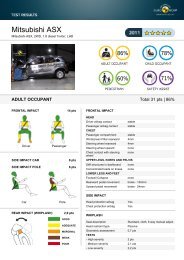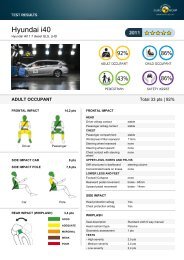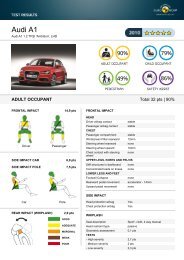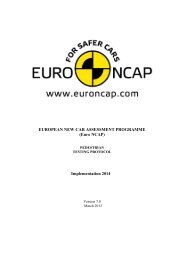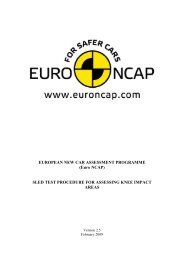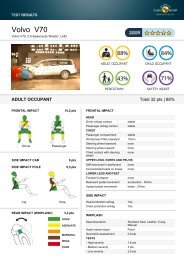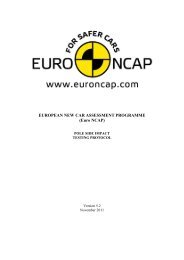Whiplash Testing Protocol - Euro NCAP
Whiplash Testing Protocol - Euro NCAP
Whiplash Testing Protocol - Euro NCAP
You also want an ePaper? Increase the reach of your titles
YUMPU automatically turns print PDFs into web optimized ePapers that Google loves.
values. Maxima for each of the four components should be calculated, considering only the portion<br />
of data from T-zero until T-HRC(end), as follows:<br />
The Nkm value is taken as the maximum value reached by any one of the four components N ea , N ep ,<br />
N fa , N fp .<br />
It should be noted which component of the four reached the maximum value and the time at which<br />
this occurred.<br />
11.7 Seatback Dynamic Deflection<br />
Using a suitable target tracking film analysis technique, measure the seatback dynamic opening from<br />
the targets defined in Figure 15 and Table 3 as follows:<br />
- Define a line between the upper and lower seatback targets, ST2 and ST3.<br />
- Define a second line between the forward and rearward sled base targets, B1 and B2.<br />
Calculate the angle between these two lines at the T-zero position. The instantaneous seatback<br />
deflection is defined as the instantaneous difference in angle between the T-zero position and the<br />
deflected position. Track the change in instantaneous angle between these two lines, throughout the<br />
dynamic test.<br />
The Seatback Dynamic Opening is defined as the maximum change in angle achieved at any time<br />
during the test between the T zero position and T-HRC(end). Note this maximum angle, and the time at<br />
which it occurred.<br />
For seats with two-point adjusting back, the same seatback deflection criterion will apply using<br />
targets ST2 and ST3, however it is recommended to use the two optional targets ST2‟ and ST3‟ such<br />
that any contribution from deflection in the two point mechanism can be understood.<br />
Version 3.1<br />
June 2011<br />
40



